Landmine
Land mine
From Wikipedia, the free encyclopedia
For other uses, see Land mine (disambiguation).
"Minefield" redirects here. For other uses, see Minefield (disambiguation).
| This article needs additional citations for verification. (July 2009) |
A land mine is an explosive device concealed under or on the ground and designed to destroy or disable enemy targets, ranging from combatants to vehicles and tanks, as they pass over or near it. Such a device is typically detonated automatically by way of pressure when a target steps on it or drives over it, though other detonation mechanisms are also sometimes used.[1] A land mine may cause damage by direct blast effect, by fragments that are thrown by the blast, or by both.
The name originates from the ancient practice of military mining, where tunnels were dug under enemy fortifications or troop formations by sappers. These killing tunnels ("mines") were at first collapsed to destroy targets located above, but they were later filled with explosives and detonated in order to cause even greater devastation.
Nowadays, in common parlance, land mines generally refer to devices specifically manufactured as anti-personnel or anti-vehicle weapons. Though many types of improvised explosive devices ("IEDs") can technically be classified as land mines, the term land mine is typically reserved for manufactured devices designed to be used by recognized military services, whereas IED is used for makeshift devices assembled by paramilitary, insurgent, or terrorist groups.
The use of land mines is controversial because of their potential as indiscriminate weapons. They can remain dangerous many years after a conflict has ended, harming the economy and civilians of many developing nations. With pressure from a number of campaign groups organised through the International Campaign to Ban Landmines, a global movement to prohibit their use led to the 1997 Convention on the Prohibition of the Use, Stockpiling, Production and Transfer of Anti-Personnel Mines and on their Destruction. Currently, a total of 161 nations are party to the Ottawa treaty.
Contents
[hide]Use[edit]
Land mines were designed for two main uses:
- To create defensive tactical barriers, channeling attacking forces into predetermined fire zones or slowing an invading force's progress to allow reinforcements to arrive.
- To act as passive area-denial weapons (to deny the enemy use of valuable terrain, resources or facilities when active defense of the area is not desirable or possible).
Land mines are currently used in large quantities mostly for this first purpose, thus their widespread use in the demilitarized zones (DMZs) of likely flashpoints such as Cyprus,Afghanistan and Korea. As of 2013, the only governments that still laid land mines were Myanmar in its internal conflict, and Syria in its civil war.[2]
Land mines continue to kill or injure at least 4,300 people every year, even decades after the ends of the conflicts for which they were placed.[3]
History[edit]
Pre-modern development[edit]
Jiao Yu in the preface to his Huolongjing Quanzhi, written in 1412 AD,[4] claimed that the 3rd-century Chancellor Zhuge Liang of the Kingdom of Shu, had used not only "fire weapons" but land mines in the Battle of Hulugu Valley against the forces of Sima Yi and his son Sima Zhao of the Kingdom of Wei.[5] This claim is dubious, as gunpowder warfare did not develop in China until the advent of the flamethrower (Pen Huo Qi) in the 10th century, while the land mine was not seen in China until the late 13th century.[6]
Explosive land mines[edit]
See also: History of gunpowder
East Asia[edit]
Explosive land mines were being used in 1277 by the Chinese during the Song dynasty against an assault of the Mongols, who werebesieging a city in southern China. The invention of this detonated "enormous bomb" was credited to one Lou Qianxia of the 13th century.[7] The famous 14th-century Chinese text of the Huolongjing, which was the first to describe hollow cast iron cannonball shellsfilled with gunpowder,[8] was also the first to describe the invention of the land mine in greater detail than references found in texts written beforehand.[7]
This mid 14th century work compiled during the late Yuan dynasty and early Ming dynasty (before 1375, when its co-editor Liu Bowendied) stated that mines were made of cast iron and were spherical in shape, filled with either 'magic gunpowder', 'poison gunpowder', or 'blinding and burning gunpowder', any one of these compositions being suitable for use.[9] The wad of the mine was made of hard wood, carrying three different fuses in case of defective connection to the touch hole.[9]
In those days, the Chinese relied upon command signals and carefully timed calculation of enemy movements into the minefield, since a long fuse had to be ignited by hand from the ambushers in a somewhat far-off location lying in wait.[10] The Huolongjing also describes land mines that were set off by enemy movement, called the 'ground-thunder explosive camp', one of the 'self-trespassing' (zifan) types, as the text says:
The Huolongjing describes the trigger device used for this as a 'steel wheel', which directed sparks of flame onto the connection of fuses running to the multiple-laid land mines underneath the carefully hidden trap.[11] Further description of how this flint device operated was not made until a Chinese text of 1606 AD revealed that a weight drive (common in medieval clockworks) had been used to work the 'steel wheel'.[11]
The way in which the Chinese land mine trigger worked was a system of two steel wheels rotated by a falling weight, the chord of which was wound around their axle, and when the enemy stepped onto the disguised boards they released the pins that dropped the weights.[12] In terms of global significance, the first wheellock musket in Europe was sketched by Leonardo da Vinci around 1500 AD, although no use of metal flint for gunpowder weapons were known before that point in Europe.[11]
Besides the use of steel wheels providing sparks for the fuses, there were other methods used as well, such as the 'underground sky-soaring thunder'.[13] The Ming Dynasty(1368–1644) text of the Wubei Zhi (Treatise on Armament Technology), written by Mao Yuanyi in 1628, outlined the use of land mines that were triggered by the heat of a slow-burning incandescent material in an underground bowl placed directly above the train of fuses leading to the mines buried 3 ft beneath.[14] The booby trap of this mine system had a mound where weapons of halberds, pikes, and lances were dug in, meant to entice the enemy to walk up the small mound and claim their stolen prize of war booty.[13]
When the weapons were removed from the mound, this movement disturbed the bowl beneath them where the butt ends of the staffs were, which in turn ignited the fuses.[14]According to the Wubei Huolongjing volume of the 17th century, the formula for this slow-burning incandescent material allowed it to burn continuously for 20 to 30 days without going out.[14] This formula included 1 lb (0.45 kg) of white sandal wood powder, 3 oz (85 g) of iron rust (ferric oxide), 5 oz (140 g) of 'white' charcoal powder (from quicklime), 2 oz (57 g) of willow charcoal powder, 6 oz (170 g) of dried, ground, and powdered red dates, and 3 oz (85 g) of bran.[14]
The Chinese also made use of the naval mine at sea and on the rivers of China and elsewhere in maritime battles.
Europe and the United States[edit]
The first known land mine in Europe was created by Pedro Navarro (d. 1528), a Spanish soldier, who used it in the settles of the Italian castles, in the beginning of the sixteenth century.
At Augsburg in 1573, a German military engineer by the name of Samuel Zimmermann invented an extremely effective mine known as the Fladdermine. It consisted of afougasse (or later, sometimes a shell fougasse, that is, a fougasse loaded not with stones but with early black powder mortar shells, similar to large black powder hand grenades) activated by a snaphance or flintlock mechanism connected to a tripwire on the surface. Combining the effects of a tripwire activated bounding fragmentation mine with a cluster bomb, it was devastating to massed attackers but required high maintenance due to the susceptibility of black powder to dampness. Consequently, it was mainly employed in the defenses of major fortifications, in which role it continued to be used until the 1870s.[15]
In Europe in the early eighteenth century, improvised land mines or booby traps were constructed in the form of bombs buried in shallow wells in the earth and covered with scrap metal and/or gravel to serve as shrapnel. Known in French as fougasse, the term is sometimes still used in the present day to describe such devices. This technique was used in several European wars of the eighteenth century, the American Revolution, and the American Civil War.
The first modern mechanically fused high explosive anti-personnel land mines were created by Confederate troops of Brigadier General Gabriel J. Rains during the Battle of Yorktown in 1862. As a Captain, Rains had earlier employed explosive booby traps during the Seminole Wars in Florida in 1840.[16] Both mechanically and electrically fused "land torpedoes" were employed, although by the end of the war mechanical fuses had been found to be generally more reliable. Many of these designs were improvised in the field, especially from explosive shells, but by the end of the war nearly 2,000 standard pattern "Rains mines" had been deployed.
Improved designs of mines were created in Imperial Germany, circa 1912, and were copied and manufactured by all major participants in the First World War. Both sides employed land mines (defensively) and tunnel mines (offensively).[15] Well before the war was over, the British were manufacturing land mines that contained poison gas instead of explosives. Poison gas mines were manufactured at least until the 1980s in the Soviet Union. The United States was known to have at least experimented with the concept in the 1950s.
Nuclear mines have also been developed, both land and naval varieties. An example is the British Blue Peacock project, while another was the U.S. Medium Atomic Demolition Munition.
Characteristics and functioning[edit]
A typical land mine includes the following components:
- firing mechanism or other device (including anti-handling devices)
- detonator or igniter (sets off the booster charge)
- booster charge (may be attached to the fuse, or the igniter, or be part of the main charge)
- main charge (in a container, usually forms the body of the mine)
- casing (contains all of the above parts)
Firing mechanisms and initiating actions[edit]
A land mine can be triggered by a number of things including pressure, movement, sound, magnetism and vibration. Anti-personnel mines commonly use the pressure of a person's foot as a trigger, but tripwires are also frequently employed. Most modern anti-vehicle mines use a magnetic trigger to enable it to detonate even if the tires or tracks did not touch it. Advanced mines are able to sense the difference between friendly and enemy types of vehicles by way of a built-in signature catalog. This will theoretically enable friendly forces to use the mined area while denying the enemy access.
Many mines combine the main trigger with a touch or tilt trigger to prevent enemy engineers from defusing it. Land mine designs tend to use as little metal as possible to make searching with a metal detector more difficult; land mines made mostly of plastic have the added advantage of being very inexpensive.
Some types of modern mines are designed to self-destruct, or chemically render themselves inert after a period of weeks or months to reduce the likelihood of civilian casualties at the conflict's end. These self-destruct mechanisms are not absolutely reliable, and most land mines laid historically are not equipped in this manner.
Anti-handling devices[edit]
Main article: Anti-handling device
Anti-handling devices detonate the mine if someone attempts to lift, shift or disarm it. The intention is to hinder deminers by discouraging any attempts to clear minefields. There is a degree of overlap between the function of a boobytrap and an anti-handling device insofar as some mines have optional fuze pockets into which standard pull or pressure-release boobytrap firing devices can be screwed. Alternatively, some mines may mimic a standard design, but actually be specifically intended to kill deminers, such as the MC-3 and PMN-3 variants of the PMN mine. Anti-handling devices can be found on both anti-personnel mines and anti-tank mines, either as an integral part of their design or as improvised add-ons. For this reason, the standard render safe procedure for mines is often to destroy them on site without attempting to lift them.
Anti-tank mines[edit]
Main article: Anti-tank mine
Anti-tank mines were created not long after the invention of the tank in the First World War. At first improvised, purpose-built designs were developed. Set off when a tank passes, they attack the tank at one of its weaker areas — the tracks. They are designed to immobilize or destroy vehicles and their occupants. In U.S. military terminology destroying the vehicles is referred to as a catastrophic kill (k-kill) while only disabling its movement is referred to as a mobility kill (m-kill).
Anti-tank mines are typically larger than anti-personnel mines and require more pressure to detonate. The high trigger pressure, normally requiring 100 kilograms (220 lb) prevents them from being set off by infantry or smaller vehicles of lesser importance. More modern anti-tank mines use shaped charges to focus and increase the armor penetration of the explosives.
Anti-personnel mines[edit]
Main article: Anti-personnel mine
Anti-personnel mines are designed to kill or injure enemy combatants as opposed to destroying vehicles. They are often designed to injure rather than kill in order to increase the logistical support (evacuation, medical) burden on the opposing force. Some types of anti-personnel mines can also damage the tracks or wheels of armored vehicles.
Under the Ottawa Treaty, signatory countries undertake not to manufacture, stockpile or use anti-personnel mines. As of 2009, it has been signed/accessioned by 156 countries. Thirty-eight countries, including the People's Republic of China, Russian Federation and the United States, are not party to the Convention.
Warfare[edit]
In military science, minefields are considered a defensive or harassing weapon, used to slow the enemy down, to help deny certain terrain to the enemy, to focus enemy movement into kill zones, or to reduce morale by randomly attacking material and personnel. In some engagements during World War II, anti-tank mines accounted for half of all vehicles disabled.
Since combat engineers with mine-clearing equipment can clear a path through a minefield relatively quickly, mines are usually considered effective only if covered by fire.
The extents of minefields are often marked with warning signs and cloth tape, to prevent friendly troops and non-combatants from entering them. Of course, sometimes terrain can be denied using dummy minefields. Most forces carefully record the location and disposition of their own minefields, because warning signs can be destroyed or removed, and minefields should eventually be cleared. Minefields may also have marked or unmarked safe routes to allow friendly movement through them.
Placing minefields without marking and recording them for later removal is considered a war crime under Protocol II of the Convention on Certain Conventional Weapons, which is itself an annex to the Geneva Conventions.
Artillery and aircraft scatterable mines allow minefields to be placed in front of moving formations of enemy units, including the reinforcement of minefields or other obstacles that have been breached by enemy engineers. They can also be used to cover the retreat of forces disengaging from the enemy, or for interdiction of supporting units to isolate front line units from resupply. In most cases these minefields consist of a combination of anti-tank and anti-personnel mines, with the anti-personnel mines making removal of the anti-tank mines more difficult. Mines of this type used by the United States are[citation needed] designed to self-destruct after a preset period of time, reducing the requirement for mine clearing to only those mines whose self-destruct system did not function. Some designs of these scatterable mines require an electrical charge (capacitor or battery) to detonate. After a certain period of time, either the charge dissipates, leaving them effectively inert or the circuitry is designed such that upon reaching a low level, the device is triggered, thus destroying the mine.
Guerrilla warfare[edit]
None of the conventional tactics and norms of mine warfare applies when they are employed in a guerrilla role:[citation needed]
- The mines are not used in a defensive role (for specific position or area).
- Mined areas are not marked.
- Mines are usually placed singly and not in groups covering an area.
- Mines are often left unattended (not covered by fire).
One example where such tactics were employed is in the various Southern African conflicts during the 1970s and 1980s[citation needed], specifically Angola, Mozambique, Namibia,South Africa and Zimbabwe.[17]
Laying mines[edit]
Minefields may be laid by several means. The preferred, but most labour-intensive, way is to have engineers bury the mines, since this will make the mines practically invisible and reduce the number of mines needed to deny the enemy an area. Mines can be laid by specialized mine-laying vehicles. Mine-scattering shells may be fired by artillery from a distance of several tens of kilometers.
Mines may be dropped from helicopters or airplanes, or ejected from cluster bombs or cruise missiles.
Anti-tank minefields can be scattered with anti-personnel mines to make clearing them manually more time-consuming; and anti-personnel minefields are scattered with anti-tank mines to prevent the use of armored vehicles to clear them quickly. Some anti-tank mine types are also able to be triggered by infantry, giving them a dual purpose even though their main and official intention is to work as anti-tank weapons.
Some minefields are specifically booby-trapped to make clearing them more dangerous. Mixed anti-personnel and anti-tank minefields, anti-personnel mines under anti-tank mines, and fuses separated from mines have all been used for this purpose. Often, single mines are backed by a secondary device, designed to kill or maim personnel tasked with clearing the mine.
Multiple anti-tank mines have been buried in stacks of two or three with the bottom mine fuzed, in order to multiply the penetrating power. Since the mines are buried, the ground directs the energy of the blast in a single direction — through the bottom of the target vehicle or on the track.
Another specific use is to mine an aircraft runway immediately after it has been bombed in order to delay or discourage repair. Some cluster bombs combine these functions. One example is the British JP233 cluster bomb which includes munitions to damage (crater) the runway as well as anti-personnel mines in the same cluster bomb.
Demining[edit]
Main article: Demining
Metal detectors were first used for demining, after their invention by the Polish officer Józef Kosacki.[18] His invention, known as the Polish mine detector, was used by the Allies alongside mechanical methods, to clear the German mine fields during the Second Battle of El Alamein when 500 units were shipped to Field Marshal Montgomery's Eighth Army.[19]
The Nazis used captured civilians who were chased across minefields to detonate the explosives. According to Laurence Rees, "Curt von Gottberg, the SS-Obergruppenfuhrer who, during 1943, conducted another huge anti-partisan action called Operation Kottbus on the eastern border of Belorussia, reported that 'approximately two to three thousand local people were blown up in the clearing of the minefields'."[20]
Whereas the placing and arming of mines is relatively inexpensive and simple, the process of detecting and removing them is typically expensive, slow, and dangerous. This is especially true of irregular warfare where mines were used on an ad hoc basis in unmarked areas. Anti-personnel mines are most difficult to find, due to their small size and the fact that many are made almost entirely of non-metallic materials specifically to escape detection.
Manual clearing remains the most effective technique for clearing mine fields, although hybrid techniques involving the use of animals and robots are being developed. Animals are desirable due to their strong sense of smell, which is more than capable of detecting a land mine.[21] Animals like rats and dogs can also differentiate between other metal objects and land mines because they can be trained to detect the explosive agent itself.[22]
Other techniques involve the use of geo-location technologies. A joint team of researchers at the University of New South Wales and Ohio State University is working to develop a system based on multi-sensor integration.[23]
The laying of land mines has inadvertently led to a positive development in the Falkland Islands. Mine fields laid near the sea during theFalklands War have become favorite places for penguins, which do not weigh enough to detonate the mines. Therefore, they can breed safely, free of human intrusion. These odd sanctuaries have proven so popular and lucrative for ecotourism that efforts exist to prevent removal of the mines.[24]
Norwegian NGO Norwegian People's Aid is one organisation involved in the safe removal of land mines.[25]
Anti-personnel mine ban[edit]
Main article: Ottawa Treaty
The use of land mines is controversial because they are indiscriminate weapons, harming soldier and civilian alike. They remain dangerous after the conflict in which they were deployed has ended, killing and injuring civilians and rendering land impassable and unusable for decades. To make matters worse, many factions have not kept accurate records (or any at all) of the exact locations of their minefields, making removal efforts painstakingly slow. These facts pose serious difficulties in many developing nations where the presence of mines hampers resettlement, agriculture, and tourism. The International Campaign to Ban Landmines campaigned successfully to prohibit their use, culminating in the 1997 Convention on the Prohibition of the Use, Stockpiling, Production and Transfer of Anti-Personnel Mines and on their Destruction, known informally as the Ottawa Treaty.
The Treaty came into force on March 1, 1999. The treaty was the result of the leadership of the Government of Canada working with theInternational Campaign to Ban Landmines, launched in 1992. The campaign and its leader, Jody Williams, won the Nobel Peace Prize in 1997 for its efforts.
The treaty does not include anti-tank mines, cluster bombs or claymore-type mines operated in command mode and focuses specifically on anti-personnel mines, because these pose the greatest long term (post-conflict) risk to humans and animals since they are typically designed to be triggered by any movement or pressure of only a few kilograms, whereas anti-tank mines require much more weight (or a combination of factors that would exclude humans). Existing stocks must be destroyed within four years of signing the treaty.
Signatories of the Ottawa Treaty agree that they will not use, develop, manufacture, stockpile or trade in anti-personnel land mines. There were originally 122 signatories in 1997; currently, it has been signed by 155 countries and ratified by 153. Another 40 have yet to sign on. The United States is not one of the signatories, based on lacking an exception for the DMZ of Korea.
There is a clause in the treaty, Article 3, which permits countries to retain land mines for use in training or development of countermeasures. 64 countries have taken this option.
As an alternative to an outright ban, 10 countries follow regulations that are contained in a 1996 amendment of Protocol II of the Convention on Conventional Weapons (CCW). The countries are China, Finland, India, Israel, Morocco, Pakistan, South Korea, Sri Lanka, and the United States.
Manufacturers[edit]
The ICBL has identified the following countries as manufacturing land mines as of August 2004. None are signatories of the Ottawa Treaty.[26]
- Burma [27] (Myanmar)
- People's Republic of China
- Cuba [28]
- India [29]
- Iran [30]
- Iraq (although production had presumably ceased with the 2003 invasion)[31]
- Nepal [32]
- North Korea [33]
- Pakistan [34]
- Russian Federation [35]
- Singapore [36]
- USA The United States is still manufacturing "non-persistent" anti-personnel and anti-tank landmines.[37]
- Vietnam [38]
Of other states which are thought to have manufactured mines recently:
- Egypt has unofficially stated that production ceased in 1988.[39]
- South Korea has stated that no mines have been produced since 2000.[40]
- An official from China stated in September 2003 that production has ceased there, since they have an ample stockpile.[41]
- In March 2004, a Libyan official stated that the country has never produced anti-personnel mines, but is known to have laid land mines in the 1970s and 1980s.[42] More recently, during the civil war in March 2011, Gaddafi's forces had sown mines around rebel-controlled areas.[43]
- A United Nations assessment mission to Peru reported that production of land mines in the country ceased in January 1999. Peru was one of the original signatories and the treaty came into force for them in March 1999.[44]
- Denmark had officially declared having 6 factories producing land mines in 1995 but production ceased since ratification of the Ottawa treaty.[45]
See also[edit]
|
|
Notes[edit]
- ^ "Land mine". Random House Dictionary (Random House, Inc). 2012.
"Land mine". Collins English Dictionary (HarperCollins). 2009. - ^ "Landmines in Myanmar: Politically explosive - The Economist". The Economist. Retrieved 29 December 2014.
- ^ "[1]". Landmine Monitor 2012. Page 1. November 2012.
- ^ Needham, Volume 5, Part 7, 27.
- ^ Needham, Volume 5, Part 7, 28.


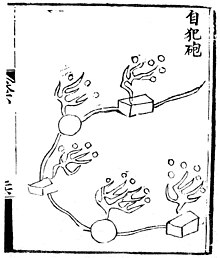
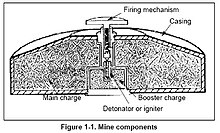
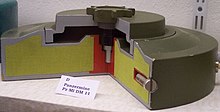

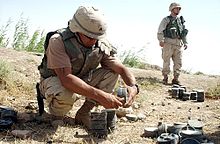
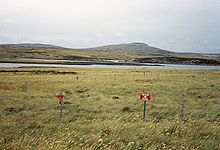
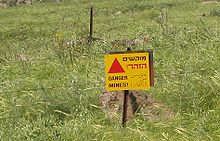
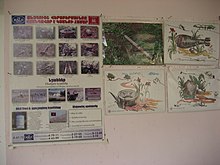



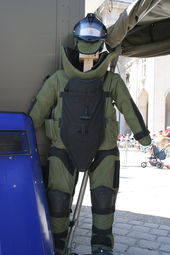

تعليقات
إرسال تعليق